¿Desea añadir la verificación en 2 pasos de Google Authenticator a su sitio de WordPress?
Las contraseñas por sí solas no bastan para proteger a los hackers y a los usuarios no autorizados. Por suerte, el uso de la verificación en dos pasos de Google Authenticator puede añadir una capa adicional de seguridad a tu sitio web.
En este artículo, le mostraremos cómo añadir la verificación en 2 pasos en su sitio de WordPress utilizando la aplicación Google Authenticator.
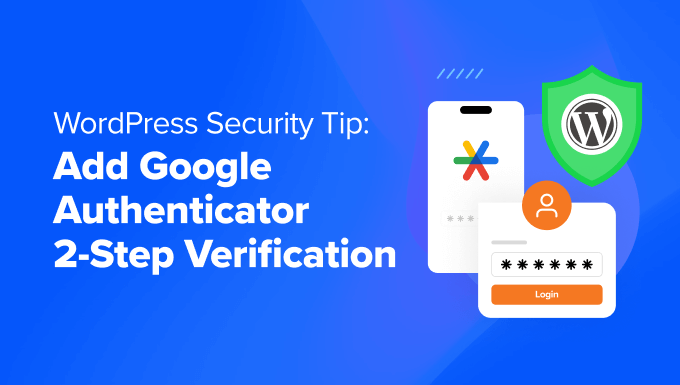
¿Qué es la aplicación Google Authenticator y por qué la necesita para su sitio WordPress?
La aplicación Google Authenticator es una aplicación móvil que añade una segunda capa de autenticación cada vez que inicias sesión en una aplicación de terceros o en un sitio web como WordPress.
Por desgracia, a veces las contraseñas pueden ser descifradas. Si utilizas la misma contraseña en varios sitios web, una fuga de seguridad en uno de ellos puede poner en peligro el resto de tus cuentas. A menudo, la gente es perezosa y no cambia sus contraseñas ni siquiera después de recibir un correo electrónico sobre un fallo de seguridad en un sitio importante.
Pues bien, la verificación en 2 pasos es la solución precisamente para eso. Incluso si el hacker conoce su nombre de usuario y contraseña de WordPress, no podrá acceder a su sitio web de WordPress a menos que tenga un código de seguridad aleatorio de tiempo limitado (proporcionado por Google Authenticator).
Dado que tu blog está directamente conectado a tu dispositivo móvil, serás la única persona con acceso a recuperar el código único para cada inicio de sesión. El código caduca en poco tiempo por motivos de seguridad.
La aplicación Google Authenticator es sólo un ejemplo de aplicación móvil que proporciona autenticación de dos factores (2FA) para varias cuentas y servicios en línea.
Genera contraseñas de un solo uso basadas en el tiempo (TOTP) que sirven como segundo factor de identificación al acceder a una cuenta.
Si aún no estás convencido de la importancia de la seguridad de WordPress, deberías ver cómo se destruyó la vida digital de uno de los autores de Wired.com.
Después de leer esa historia, nos subimos al carro de la autenticación en dos pasos para nuestras cuentas de Google y la mayoría de los demás servicios que ofrecen esta función. Si te preocupa la seguridad tanto como a nosotros y valoras tu blog, deberías seguir este consejo para mejorar la seguridad de WordPress.
Nota: Google Authenticator sólo funciona en dispositivos iOS, Android, Windows Phone, webOS, PalmOS y BlackBerry. En otras palabras, necesitarás tu smartphone para iniciar sesión en tu sitio web.
Para mejorar aún más tu seguridad, te recomendamos que busques también otros métodos. Por ejemplo, un software como 1Password puede ayudarte a gestionar tus contraseñas en un único lugar y garantizar que son lo suficientemente seguras como para resistir a posibles piratas informáticos.
Dicho esto, pasemos al tutorial sobre cómo añadir la verificación en 2 pasos de Google Authenticator a su sitio de WordPress.
Cómo añadir Google Authenticator en WordPress
Lo primero que tienes que hacer es instalar la aplicación Google Authenticator en tu teléfono. Vamos a utilizar la terminología de iOS para este tutorial, pero el proceso es similar para otros dispositivos también.
Paso 1: Instale la aplicación Google Authenticator en su dispositivo móvil
Visite la App Store, busque “Google Authenticator” y, a continuación, haga clic en “Instalar” la aplicación.
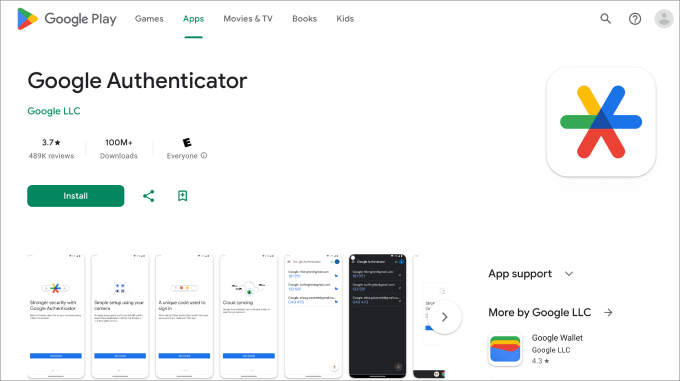
Ahora, volvamos a su panel de WordPress.
Paso 2: Instalar el plugin Google Authenticator de MiniOrange
Instale y active el plugin Google Authenticator de MiniOrange. Para más detalles, puedes consultar nuestra guía paso a paso sobre cómo instalar un plugin de WordPress.
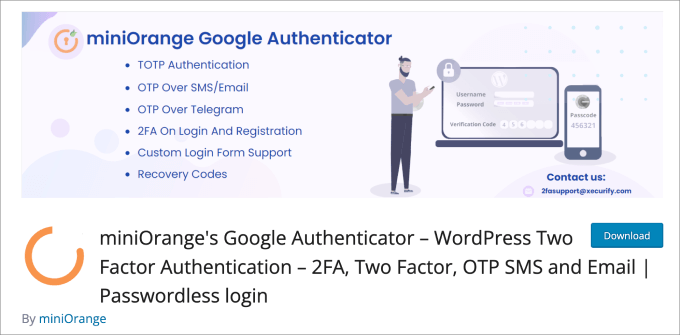
Se trata de un plugin gratuito para WordPress que ayuda a proteger tu sitio de accesos no autorizados. Cada vez que inicies sesión en WordPress, se te pedirá que introduzcas la contraseña de un solo uso de la aplicación Google Authenticator para verificar tu identidad.
Al activar el plugin, aparecerá un asistente de configuración. Solo tienes que seguir el proceso para configurar la autenticación de dos factores de Google Authenticator en WordPress.
Paso 3: Completar el asistente de configuración
Para empezar, haz clic en el botón “Empecemos”.
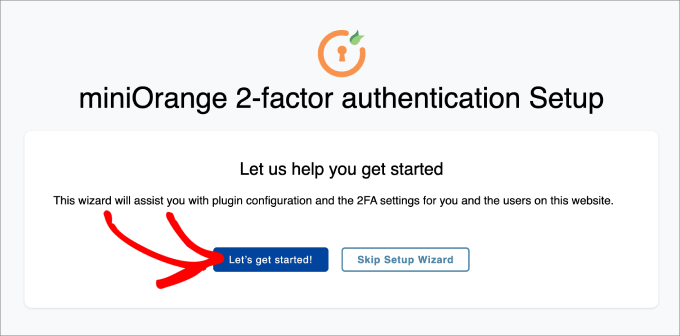
A continuación, se le preguntará si desea configurar 2FA después de su primer inicio de sesión o en el panel de control del plugin. Cualquiera de los dos métodos es válido.
Haz clic en “Continuar configuración”.
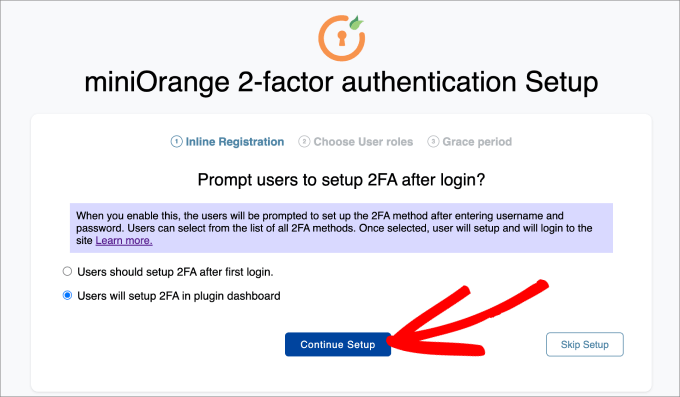
El siguiente paso es elegir a quién quieres aplicar el 2FA. Puedes seleccionar a todos los usuarios para máxima seguridad, o puedes hacer que sólo se aplique a ciertos roles de usuario.
A continuación, pulsa “Continuar configuración”.
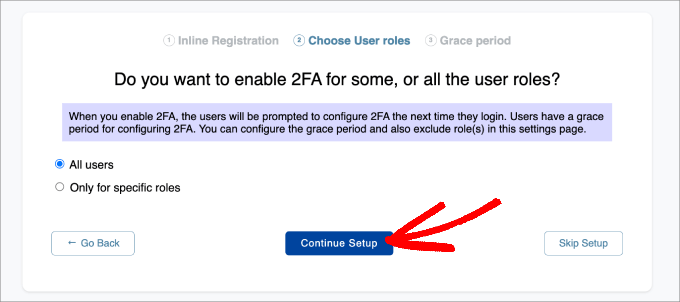
Por último, se le preguntará si desea aplicar directamente la 2FA de forma inmediata o dar a los usuarios un periodo de gracia.
Si decides conceder a los usuarios un periodo de gracia, puedes seleccionar la duración en horas y días. Una vez completado, haz clic en “Todo listo”.
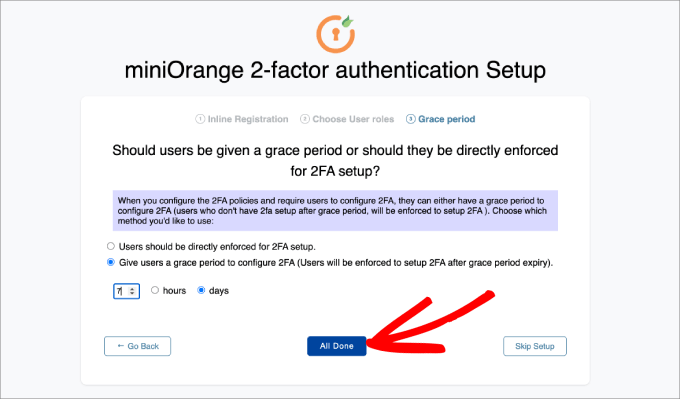
Ahora que has terminado con el proceso de configuración, puedes decidir si quieres configurar 2FA para ti ahora o más tarde.
Sigue adelante y pulsa el botón “Configurar 2FA para ti”.
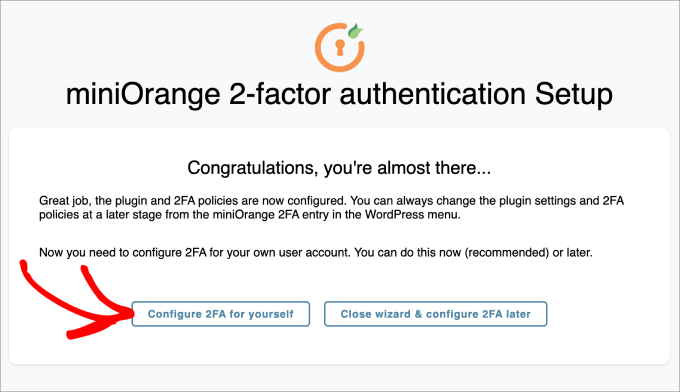
A partir de aquí, se le pedirá que introduzca el método de autenticación de 2 factores que desea añadir a su sitio de WordPress.
Para este tutorial, elegiremos ‘Google/Microsoft/Authy Authenticator’. A continuación, pulse el botón “Guardar y continuar”.
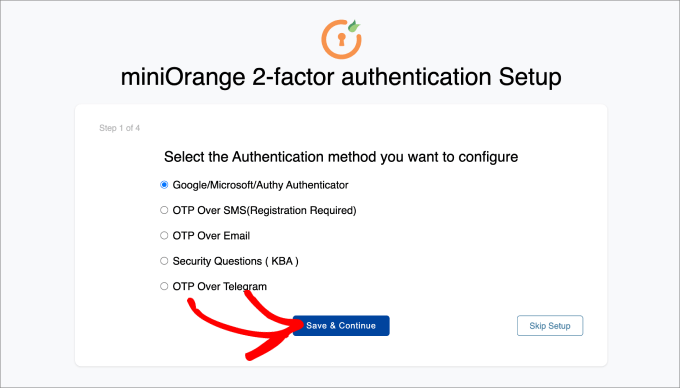
A continuación, se te pedirá que escanees el código de barras que aparece en la pantalla. Eso significa que tendrás que abrir la aplicación Google Authenticator en tu teléfono y escanear el código de barras que se muestra.
En la aplicación Google Authenticator de tu dispositivo móvil, pulsa el icono “+” de la parte inferior y selecciona “Escanear un código QR”. A continuación, apunta la cámara del teléfono a la pantalla del ordenador para escanear el código de barras.
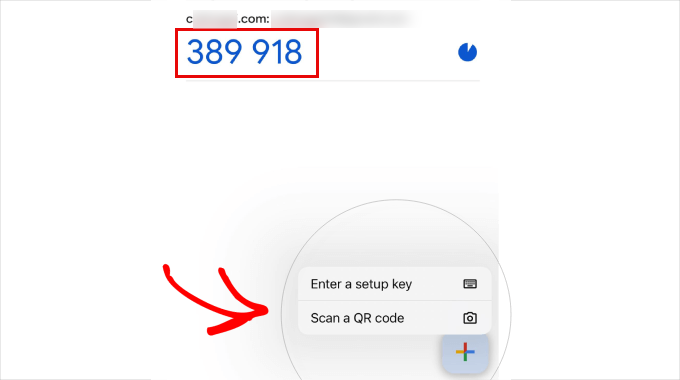
A partir de aquí, aparecerá una contraseña de un solo uso (OTP) en su dispositivo móvil.
Escríbelo en el paso 2 de tu ordenador. A continuación, haz clic en “Guardar y continuar”.
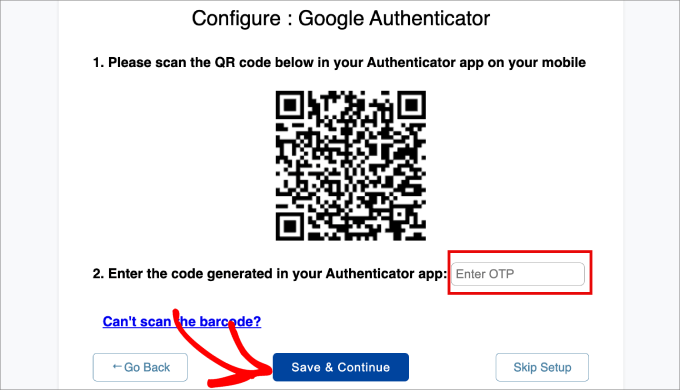
Ahora, deberías recibir un mensaje que dice que has configurado correctamente la autenticación de dos factores.
Sólo tienes que seleccionar “Ajustes avanzados”.
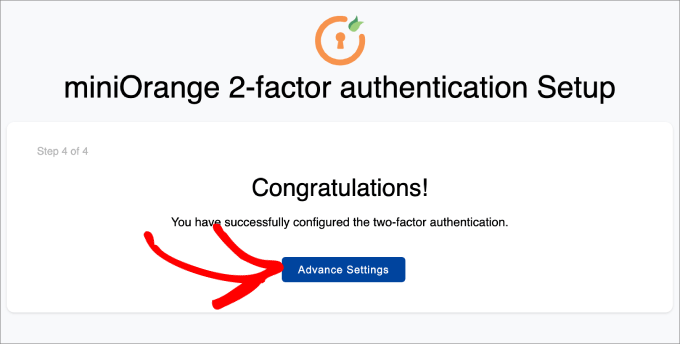
Paso 4: Añadir preguntas de seguridad
Además de añadir la autenticación de 2 factores de Google Authenticator, probablemente también quieras añadir preguntas de seguridad.
Si no puedes acceder a tu aplicación Google Authenticator, podrás iniciar sesión en tu sitio web de WordPress si respondes a las preguntas de seguridad que hayas configurado para ti.
Tendrás que dirigirte a la página Mini Orange 2-Factor ” Two Factor en tu panel de administración de WordPress. A continuación, en la pestaña Configurar 2FA para mí, busca el método Preguntas de seguridad y haz clic en “Reconfigurar”.
Ten en cuenta que también puedes configurar otros tipos de métodos de autenticación de dos factores, como la verificación por correo electrónico, OTP por SMS, OTP por correo electrónico, OTP por Telegram e incluso Duo Authenticator.
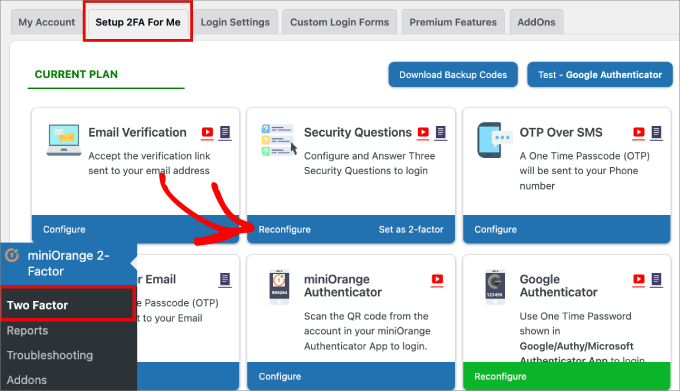
A continuación, podrás seleccionar hasta tres preguntas de seguridad. Puedes seleccionar dos de ellas en un menú desplegable, y la tercera será una pregunta personalizada que se te ocurrirá a ti.
A continuación, escribe la respuesta para cada una de ellas y pulsa el botón “Guardar”.
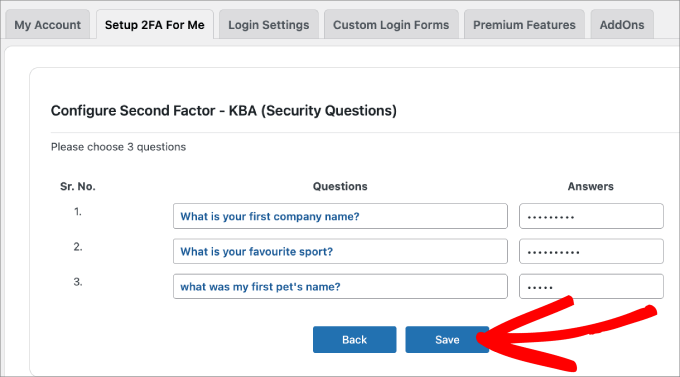
Paso 5: Pruébelo usted mismo
Una vez configurado todo, puedes probarlo tú mismo.
Simplemente cierre la sesión de su panel de WordPress e intente volver a iniciarla.
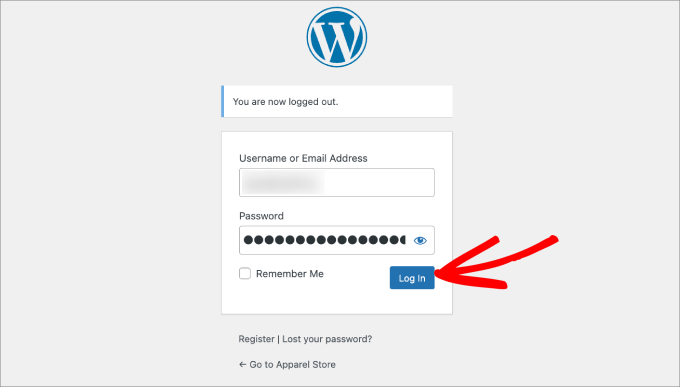
Accederás a una página en la que podrás responder a las preguntas de seguridad o utilizar el Autenticador de Google para introducir tu contraseña de un solo uso.
Seleccione la opción “Google Authenticator”.
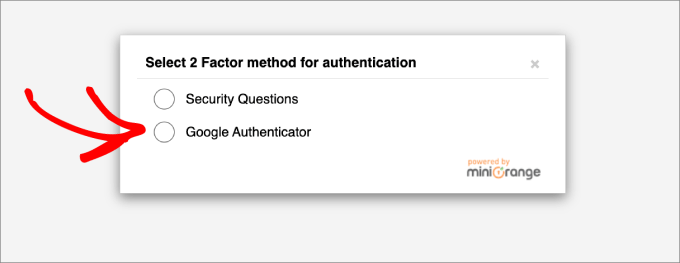
En esta pantalla, se te pedirá que introduzcas tu OTP desde tu aplicación Google Authenticator.
Introduzca el código y haga clic en “Validar”.
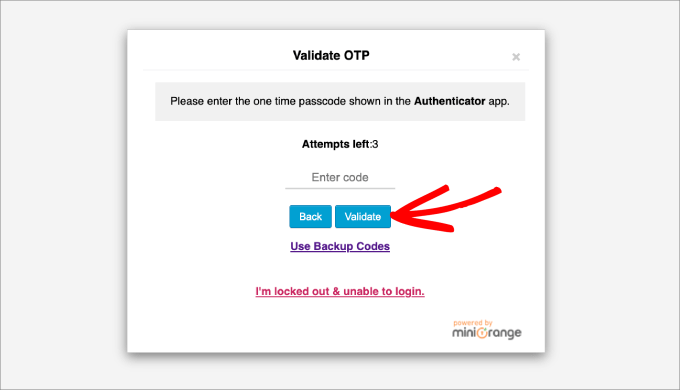
Ahora, aterrizará de nuevo en su panel de administración de WordPress, como de costumbre.
Por último, recomendamos a todo el mundo que active la verificación en dos pasos en sus cuentas de Google. También puedes configurarla con Google Authenticator, como se muestra en este tutorial.
Esperamos que este artículo te haya ayudado a añadir la verificación en 2 pasos de Google Authenticator a tu sitio web de WordPress. También puedes consultar nuestro artículo sobre los errores más comunes de WordPress y cómo solucionarlos o nuestra guía definitiva para aumentar la velocidad y el rendimiento de WordPress.
If you liked this article, then please subscribe to our YouTube Channel for WordPress video tutorials. You can also find us on Twitter and Facebook.





David
I just tried this and it locked me out of my website. The codes weren’t working. How can I remove this authenticator and get my site back. Pls help
WPBeginner Support
You can deactivate the plugin following our guide below:
https://www.wpbeginner.com/beginners-guide/how-to-easily-deactivate-wordpress-plugins/
Admin
ANOOP VAISH
what have to do if mobile lost please discribe
WPBeginner Support
Hi Anoop,
In that case you will have to deactivate WordPress plugins via FTP to login.
Admin
yasir khan saqlaini
i am using this feature but i want to know how will i get google authenticator code while login wp dashbord.
WPBeginner Support
Hello Yasir,
You will get Google Authenticator code inside the app you installed on your phone.
Admin
Danny D
I’m surprised that nobody has mentioned Clef. This is the best 2-factor authentication for WordPress (and a lot of other websites as well). No passwords involved after initial setup. They have iOS and Android apps as well as chrome extensions to help with the setup. Works like a charm for me.
Sacha
I agree – I absolutely love Clef. It makes things so easy and secure.
rohit
Message To Syed Balkhi,
Well Fake GURUs Try to hack my website 100 Times a day Finally I have started using Google Authenticator and I change my Password every 10 days. I appreciate Your skills Thanks a lot.
Akhil K A
Hi.
The plugin is compatible up to WP 3.8.8
Can I install on the latest version?
Thanks.
WPBeginner Support
Yes you can. Please see, Should you install plugins not tested with your WordPress version.
Admin
Erick Perez
you guys don’t use this on your own website, how come?
handi priyono
Hello dude,, thanks for help me by writting this useful post.
this post very help me to prevent hacker to login to my web. thanks !!
WPBeginner Staff
Please contact WordPress.com support.
WPBeginner Staff
You can deactivate the plugin using an FTP client. See our guide on how to disable all plugins using FTP without wp-admin access.
Kavitha Krishnan
I am using the WP.com hosting. So this option will not work for me.
Kavitha Krishnan
Hi, I have uninstalled the Google app by mistake now i am unable to login to WP. i requested the account recovery also nothing worked. Is there any solution for my issue.
Sriram
Hi,
What if I have a custom login page? How can I integrate this plugin in my custom login page?
Lorena Dennison
I have my wordpress blog set up to receive a SMS code to log in… well my cell phone is shut off and can’t get the SMS Code…. so how can I log in and take that SMS off my blog?
WPBeginner Support
You can’t unless you disable the plugin used to enable this two step authentication.
Admin
Kamran Abdul Aziz
Aha, Google Authenticator & Authy they always works for me,
However is there any option where we can force users to use 2 Step verification?
Am not allowing my users to access the Backend, Their profile & everything is limited to front end only.
I don’t want them to access their backend & Setup 2 step.
Any solutions?
Brenda
I installed the two-step google authenticator, both the app and the plugin. I updated the app and now all of the sudden I can’t generate a verification code, and therefore have not been able to login to my WordPress. I have no idea what “login using FTP” or who my webmaster is. I signed up for a free worpress account because I wanted to start a little blog and now it appears to me I have to be a computer wizard to do something so basic, which is login!! Can you please help? And explain it to me like I’m a third grader. I don’t have the tech savviness you all do.
Thank you in advance
WPBeginner Support
You mentioned that you have a free WordPress account. Does your blog address has wordpress.com in it? If that’s the case, then this tutorial is not for you. You need to contact WordPress.com support for assistance.
Admin
Zulfa Permata Suri
I have set up two-step authentication for my wordpress blog. Suddenly I cant log-in it said the authentication code that i type is invalid and now I am locked out of my wordpress account.
Help me please, I want to use my wordpress but I cant log-in T.T
Editorial Staff
Login to WordPress using FTP and delete the plugin.
Admin
Alyson
Hi – I lost my phone with my google authenticator on it and now I can’t get into my site. I don’t know how to log in using ftp ..
HELP?
Thanks!
Editorial Staff
Contact your webhosting provider. They’re the only one who have your FTP access and can help delete the plugin.
Cara Isaacs
Hey,
I recently set up two-step authentication for my wordpress blog. Downloaded the google app and it all worked fine with log-in. Then changed the name of my blog and accidentally deleted the google authenticator app and now I am locked out of my wordpress account as it asks for the code yet I cannot generate a code because I can’t access my account to get the key.
I hope you can help.. PLEASE!
Editorial Staff
Use FTP to delete the plugin.
Admin
Cara
Thanks for your reply. I just downloaded the ftp software except it can’t seem to connect to the server. Looks like I will be starting a new blog…
Editorial Staff
Hey Cara. Starting a new blog is not a good solution. Please get in touch with your hosting provider or send us an email. We can help you restore this and get it sorted out.
Everett Patterson
Well I did some research and found that the hosting time may be different than the phone time and may cause issues with the codes.
I was able to log in to my Cpanel and delete the plugin. I still want to use it though so I added it back in and used the relaxed mode this time. Seems to be working now.
Thanks for this post, very helpful.
Everett Patterson
Uh Oh. I locked myself out of my site.
Here’s what I did:
Added the plugin to my blog
Activated it, but didn’t check the “Active” box
Added authenticator to my android
Scanned the QR code
Checked “Active” box
Signed out
My phone gives me a new code every minute, but none of them work. What now?
Austin
I did this too…. I logged into my host via FTP and deleted the Google Authenticator plugin.
Then I went through the process again and the plugin/app combo worked like a charm!
Hope you’re able to get back into your site (if you haven’t already).
Maria Muir
I installed the plugin, followed the simple steps and have now been locked out of my site. I also have the failed attempt log in plugin which has blocked me for 3 failed attempts so now have to wait. I did put in the correct details and authentication code, I tripled checked the installation and settings, all are correct. So why can’t I log back in?
Editorial Staff
Run this plugin in the relaxed mode.
Admin
Chris Burbridge
It does concern me that when you install the plugin, you have to activate it user by user. That doesn’t make sense to me. Wouldn’t an administrator want to have it work for all users, otherwise there are holes in the net?
I have been trying this one, which is really great — http://wordpress.org/extend/plugins/duo-wordpress/ — there’s a free option, and it works similarly. It is very slick, with a smart phone.
Editorial Staff
The reason why Google Authenticator requires each user to enable it themselves is because they have to connect their device with it. Google Authenticator is a great solution if you don’t like paying for a service. We are using it on our site. All we did was send an email to all users and ask them to turn it on.
Yes it requires a little bit of extra work, but it is surely worth it for a small company like ours. If you have hundreds of people in your team, then it would be worth to automate it with a service like the one you linked.
Admin
Michael
This works great with Limit Login Attempts plug in. Great security feature if your blog does not have SSL capabilities.
yatin
i love your site very helpful
very helpful
what if Google authenticator app got uninstalled by mistake !!!!
after that how can i login in my wordpress site ?
Editorial Staff
Delete the plugin. Then re-do the process.
Admin
Gerard
Good article, good plugin and good subject
Love Authenticator app.
Kind regards,
Gerard.
Umer Rock
Buy Syed bro it is not linked to google account ? then why you used google athenticator word , i think it is kind of 2 step verification system only,
Editorial Staff
If you read the post carefully, you will see that the app this plugin uses is called Google Authenticator. Without using that application this would not work. If you actually follow the tutorial and download the application, then you will see that application is made by Google Inc.
Admin
Hadley
I was able to successfully set up the Google Authenticator app for myself as an admin on my site, but was not able to set it up successfully for an editor on the same site. On the other user’s profile settings under Google Authenticator, the only options are to hide the Authenticator settings or make the user active with Google Authenticator. There aren’t the same options to type in a site description or view a secret code. After installing the app successfully to the other user’s phone, she was not able to sign in to the site and I’m wondering if this is due to the profile settings. Any advice?
Editorial Staff
Interesting. It is probably best to contact the plugin author and see what the issue could be.
Admin
Ahmad Awais
Putting our login authentication in hands of a 3rd party plugin?
Not more than 5k Downloads! What about its authenticity? Are you using it yourself #justcurious.
I am happy with .htpaswrd file.
Should we trust this code?
Except this a nice plugin for sure.
Editorial Staff
The plugin has low downloads because not many people have jumped on board with this 2-step verification method. If you are happy with .htpaswd, then good for you. Yes, we are using it on our site along with all the other security measures.
Admin
Dilawer Pirzada
Buzz! After my great efforts on securing WordPress blog from spammers and hackers, I myself today found a great plugin to stop hackers!
Thanks for the plugin!
Santel Phin
Hi,
I have completed the setup and it works great. But do I have possibility to choose how to the verification code.
I did the same setup for my Google account, but it send via SMS in stead. And I do prefer this mode as well if it is possible.
But I don’t see any setting to chose send via SMS. Hope you can give me an idea if it is possible or not.
Thanks
Editorial Staff
No the SMS option is not available. Mainly because for that you need a sending service which blogs are not equipped with. There is another plugin called “2-step verification” that has the option to email the code. But no SMS.
Admin
Navneet Singh
Plugin looking simple and POWERFUL.!!
Saad
This Will Be Useful For Stopping Brute Force
Geoffrey Gordon
Thanks Syed
WordPress security has always been a big issue in general, so the more educated people are regarding WordPress security the better. This is especially important as people see WordPress as a quick way to get a website up and running. Then one day without warning BANG their website is down by some hacker.
Busy checking out the Google authentication plugin for WordPress, looks good. I have ask though with all the security plugin’s installed on ones blog plus other plugins it tends to slow down the website. Sometimes its better to code what a plugin can do straight into your blog, rather than keep adding another plugin.
Editorial Staff
This plugin works in the backend, so it will not have an impact on your site’s load time on the front-end.
Admin
Landfoci
Good plugin. Thanks your share